I try to revisit each MLB park at least once every 3-4 years, but for whatever reason, I’ve neglected to see the Mariners’ ballpark recently. In fact, I hadn’t attended a game at the Ballpark That Saved Baseball in Seattle since 2011, in what was by far my longest ballpark drought.
So naturally, it made perfect sense to finally revisit T-Mobile for the last homestand (June 30-July 2) before it hosts the 2023 All-Star Game events, with the anticipation of reviewing certain aspects of the park before and during the Midsummer Classic. Everything was in tip-top shape for the national spotlight.

T-Mobile Park has historically been considered one of the best parks in baseball, receiving rave reviews upon opening for its “umbrella”-style retractable roof that doesn’t enclose the park and unparalleled array of modern amenities. With a $500+ million price tag, an exorbitant amount for the late 1990s, almost no expense was spared.
By the late 2010s, it seemed like T-Mobile Park had faded from the limelight as a “must see” baseball cathedral, perhaps largely because of the Mariners decades-long irrelevance coupled with geographic isolation. Hopefully the Mariners’ recent success and the All-Star Game bring it the attention it deserves!
Now, I have some issues with the stadium’s underlying design. For just one example, the exterior architecture is utterly disjointed, with the third base side wrapped in red brick and the first base side exposed in unadorned steel, to say nothing of the clashing of the jet-black retractable roof/red brick.
But T-Mobile is undoubtably a gem. And in the spirit of the occasion, this will be a totally positive piece. Here are 12 things you must experience at the Seattle Mariners’ T-Mobile Park, besides the game, of course!
“The Pen”
“The Pen” is a social gathering area adjacent to both bullpens at field level in left field. While many parks have crowd-pleasing setups allowing views into bullpens, The Pen allows fans to watch pitchers warm up mere feet away unobstructed by any visual barriers. It’s on the shortlist of most fan-friendly spaces in MLB.
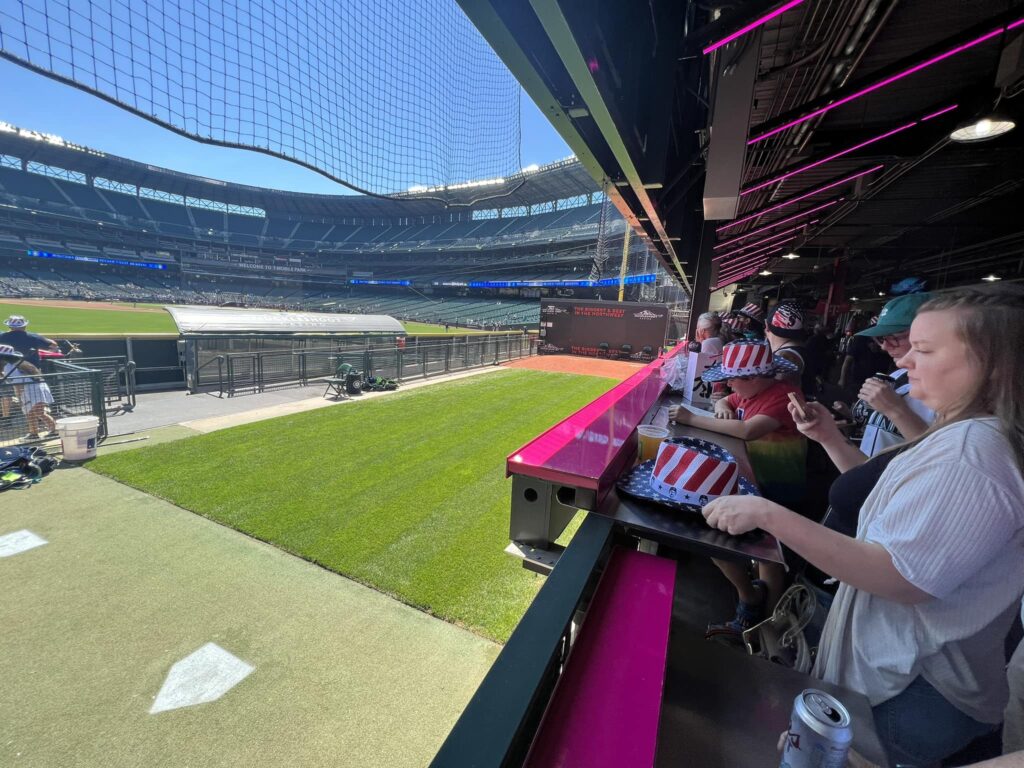
The Pen also features lounge areas, the Bullpen Bar, live music, and a center field patio where fans can walk up right against the fence. It’s absolutely the first place to check out when visiting T-Mobile Park.
I briefly discuss T-Mobile Park’s delectable grub below, but it’s also where you’ll find some of the stadium’s best food.
Local eateries in The Pen have varied widely since the concept debuted — in the past, the Mariners have mingled Mexican tortas stands and Parisian crepe kiosks, offered lobster rolls and local BBQ — but the restaurant-caliber quality has consistently been the very best of the best.

This year there’s Din Tai Fung, Lil’ Woody’s (best burgers), Ballard Pizza Co., along with Edgar’s Cantina.
The Rotunda, Including the Chandelier of Spiraling Bats
Many post-1990 “retro” MLB parks attempted to emulate Ebbets Field’s famous home plate rotunda — as many as six depending on your definition — but Seattle’s version is second in quality only to Citi Field’s Jackie Robinson Rotunda.

Inside, fans are greeted by a bedlam of 1000 translucent bat replicas forming a massive swirling chandelier (called, “The Tempest”), serving as the focal point of the rotunda’s interior. The bats are molded of resin and mounted on brushed aluminum spiraling forms. Lit with flickering incandescent lights, the piece conveys the power and movement of the swing of the bat.
Pay attention to the floors and ceilings as well. The ground at street level consists of hues of seam foam greens and blues evoking the ocean, while the brown staircase represents the sands of the Pacific Coast. The sun penetrates the rotunda’s open windows to highlight these concepts, as do the suspended blue light bulbs.

Here’s the closeup. It’s one of baseball’s most rousing entryways and a prime example of T-Mobile Park’s attention to detail and qualities that go above and beyond what you would expect from a sports facility.
The Rest of the “Art in the Park”
Seattle’s T-Mobile Park is known for its phenomenal “Art in the Park.” In fact, the Mariners’ pad has one of the most comprehensive public art displays in all of sports. It’s one of many features that cultivated T-Mobile Park’s reputation as one of the best parks in MLB.
While The Tempest bat chandelier is the park’s signature piece, there are many other displays of note. My other favorite is the 27-foot diameter terrazzo compass rose that sits on the main concourse behind home plate facing the rotunda, very much part of the rotunda’s appeal.
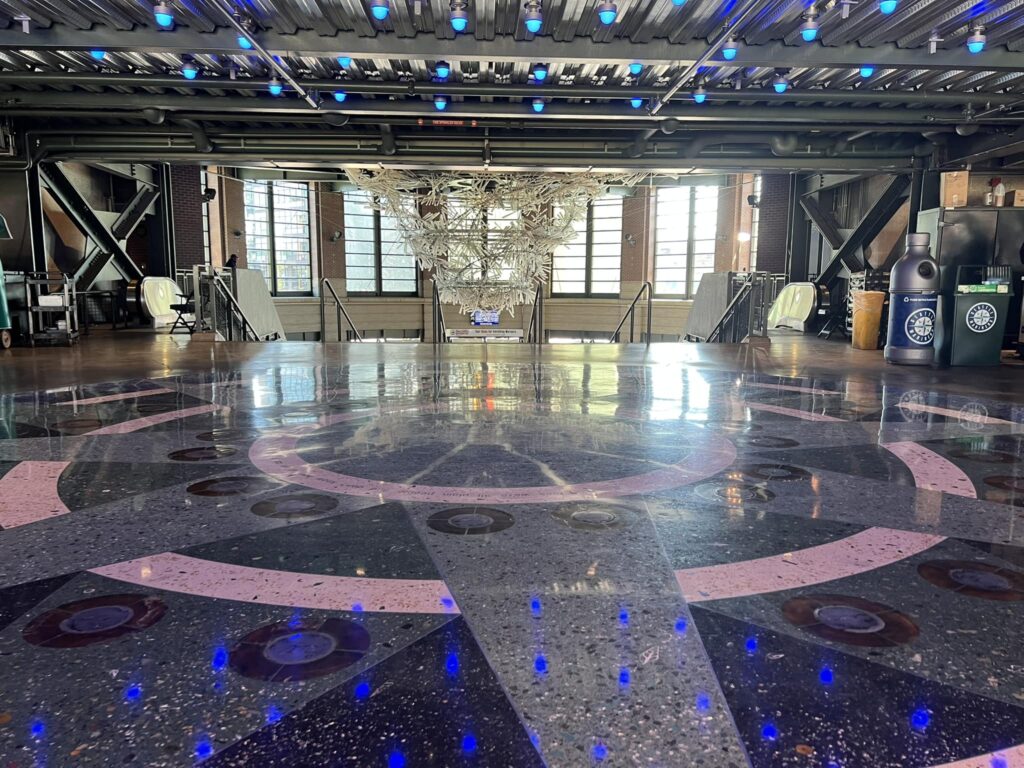
A timeless icon of sea navigation and keystone of the Mariners’ logo, thirty-two mirrored cast glass rings, embedded within the terrazzo, surround stainless steel disks etched with the signatures of the inaugural team, thus providing a time capsule of the moment the ballpark officially opened on July 15, 1999.
Other iconic artistic flourishes include (a) “The Crowd,” a colorful 24-foot-long porcelain enamel showcasing fans and players, (b) Baseball “Quilts,” with recycled materials creating logos of all MLB teams, (c) “The Defining Moment,” capturing the Mariners’ win over the Yankees in the ’95 Division Series, and (d) “Positions on the Field,” murals in the upper deck concourse portraying legends representing the nine positions of the field.
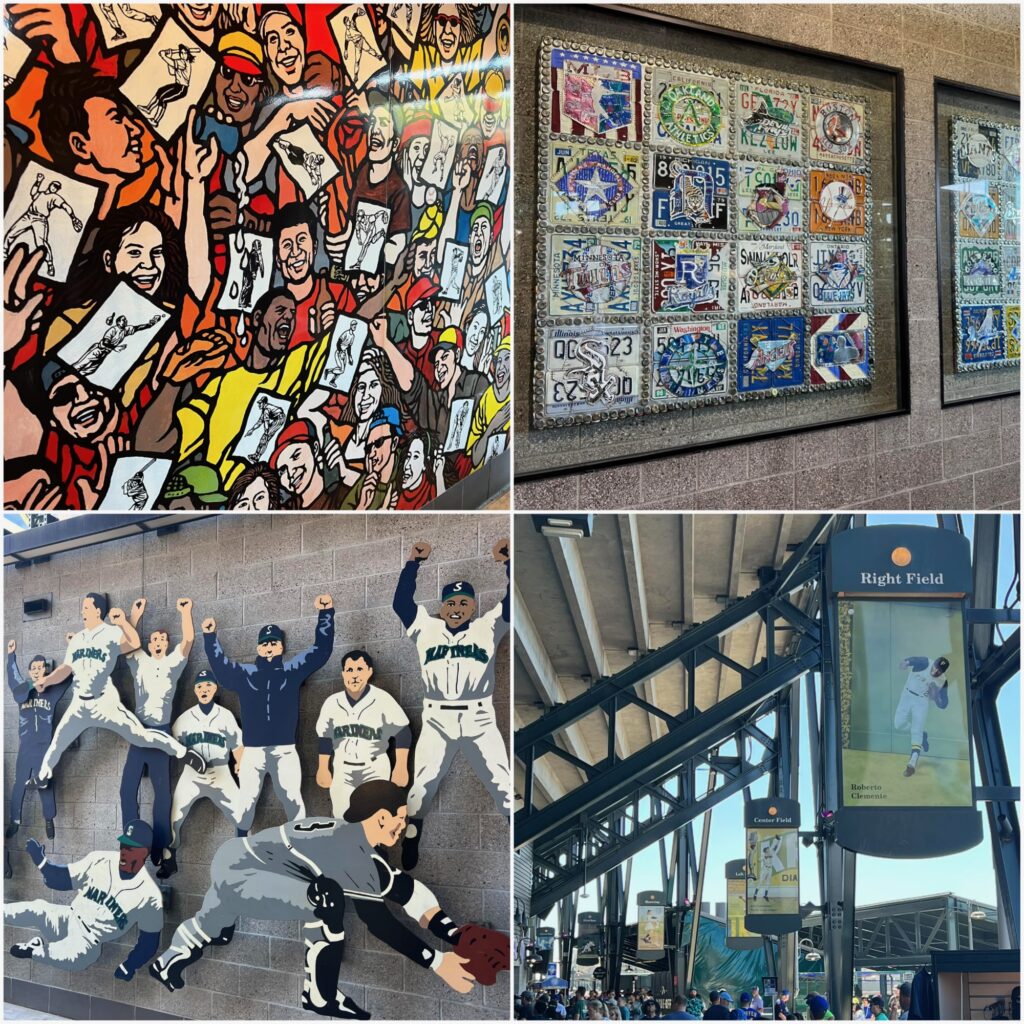
That just scratches the surface. Also don’t miss “The MITT” outside of the left field gate, a popular space to meet before and after the game.
Postcard Views from the Upper Deck in Right Field
Now for something a bit more accessible! T-Mobile Park’s most scenic seats are down the first base line in the upper deck. You can see the Downtown skyline, the Space Needle, and even the Seattle Great Wheel (Ferris wheel) at Pier 57.

Move further into the right field upper deck, and you can catch glimpses of Elliott Bay and distant views of the Olympic Mountain ranges.
Even if you have seats down low, it’s absolutely worth your time to walk the upper deck for 15 minutes of so, especially because these panoramic views can’t be seen from the lower bowl.
The Food
T-Mobile Park has some of MLB’s very best food, with only San Diego’s Petco Park and New York’s Citi Field in the conversation for the #1 spot.
I’m rolling out a full food guide shortly, but highlights include:
- Seafood from Seattle institution Ivar’s and Wayback Crab Shack
- Chinese cuisine from Din Tai Fung
- Sushi and Poke from Just Poke
- Hawaiian grub from Marination
- Outstanding Pizza from both Ethan Stowell icon Ballard Pizza Co. and Detroit-style Moto Pizza (with a Filipino sensibility)
- Burgers from Li’l Woody’s
- Oaxacan cuisine from Edgar’s Cantina
- Mac n’ Cheese by Beechers
- Choice desserts from Salt & Straw, and
- Healthy fare like acai bowls and avocado toast.
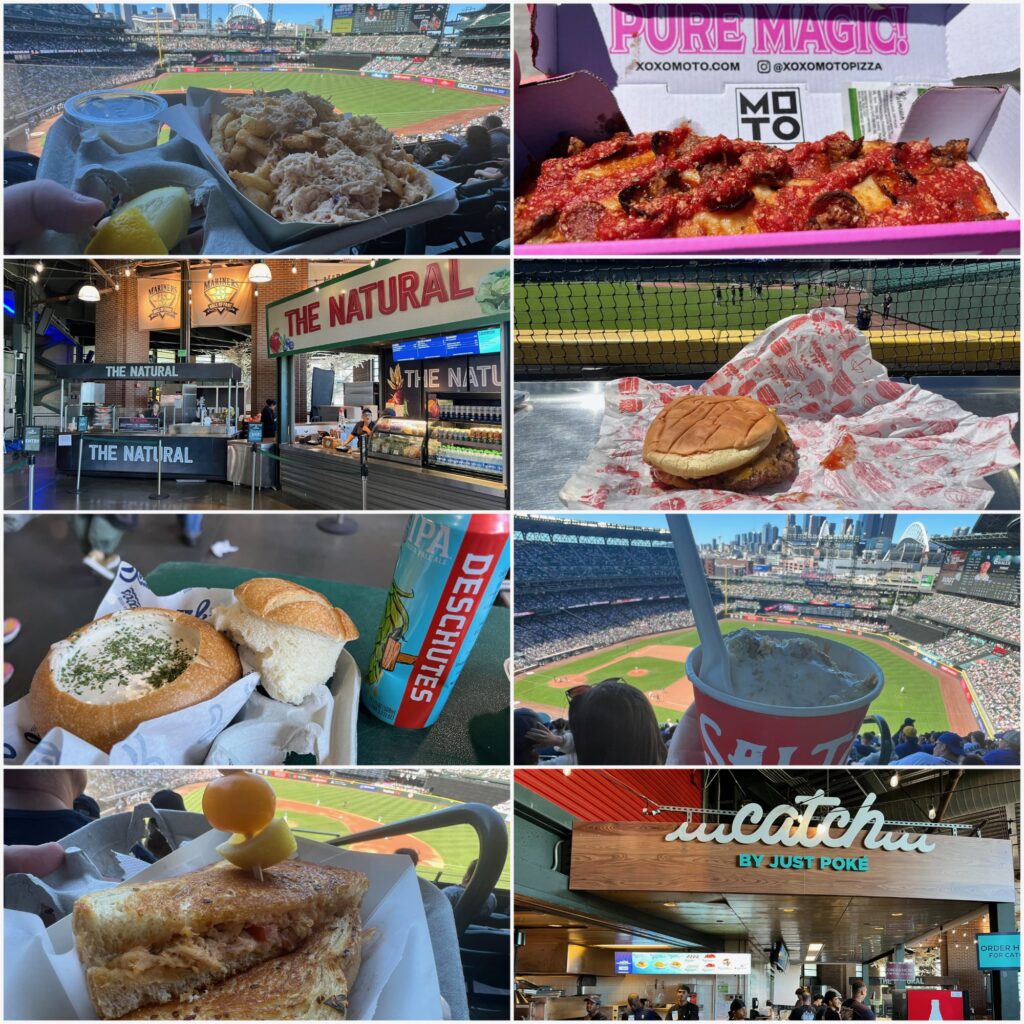
If you have to pick one, go with a pie from Moto Pizza. Eater called it Seattle’s buzziest pizza, because there is a month’s long wait to get it the city’s main location. Naturally, another local publication declared that T-Mobile Park is essentially the only place to get a pie right now.
The Craft Beer (if you’re inclined to imbibe)
T-Mobile Park also has some of baseball’s best craft beer, with only the Padres’ aforementioned pad in the conversation for #1 here.
First of all, the distribution is nearly unmatched. Other parks may have dedicated areas/social spaces/restaurants that offer more beer in one place (see San Francisco’s Oracle’s Public House or White Sox park’s Craft Kave), but it seems like every stand in Seattle’s park has high-quality local craft beer, even in the upper deck.

They also utilize cutting-edge grab and go technology in their “Walk Up Markets” with tons of choice cans. Just put in your card before entering the market, and you’re set. The systems can tell what you took from the market upon exiting, so you don’t have to check out.
Notable offerings include Pacific Northwest icons like Fremont Brewing, Reuben’s Brews, Georgetown Brewing, Bale Breaker, Black Raven Brewing, Ecliptic Brewing, Ninkasi Brewing. That’s just the tip of the iceberg. This is a craft beer lovers haven.
The Statues
The Ken Griffey Jr. statue outside the home plate rotunda entrance and the adjacent Edgar Martinez statue are popular meeting spots before the game.
Outside of the entrance to the kid’s playground in center field, the Children’s Hospital Wishing Well features a young child with a baseball bat preparing to swing for the fences. The Wishing Well also features waterspouts around the statue for a fountain effect, which is supposed to be activated each time a Mariners player hits a home run. Not sure if they still do this.

The statue of broadcaster Dave Niehaus on the center field concourse is the best of the bunch. Many subtle touches with this one, including a tie from Dave’s collection (hand-picked by wife Marilyn and daughter Greta) and a scorebook open to Game 5 of the American League Division Series game against the Yankees (with Dave’s actual notes from the game). This may be the most detailed statue in all of baseball!
Edgar’s Cantina
Edgar’s Cantina is technically part of The Pen, but it can be easy to miss in the left field corner, so I’m including it separately.
The full-service eatery and bar is adorned with memorabilia from Edgar Martinez’ career and offers great standing room views from tables against the left field fence below the manual scoreboard. A food menu, specialty cocktails, and full waiter service is available at Edgar’s too.
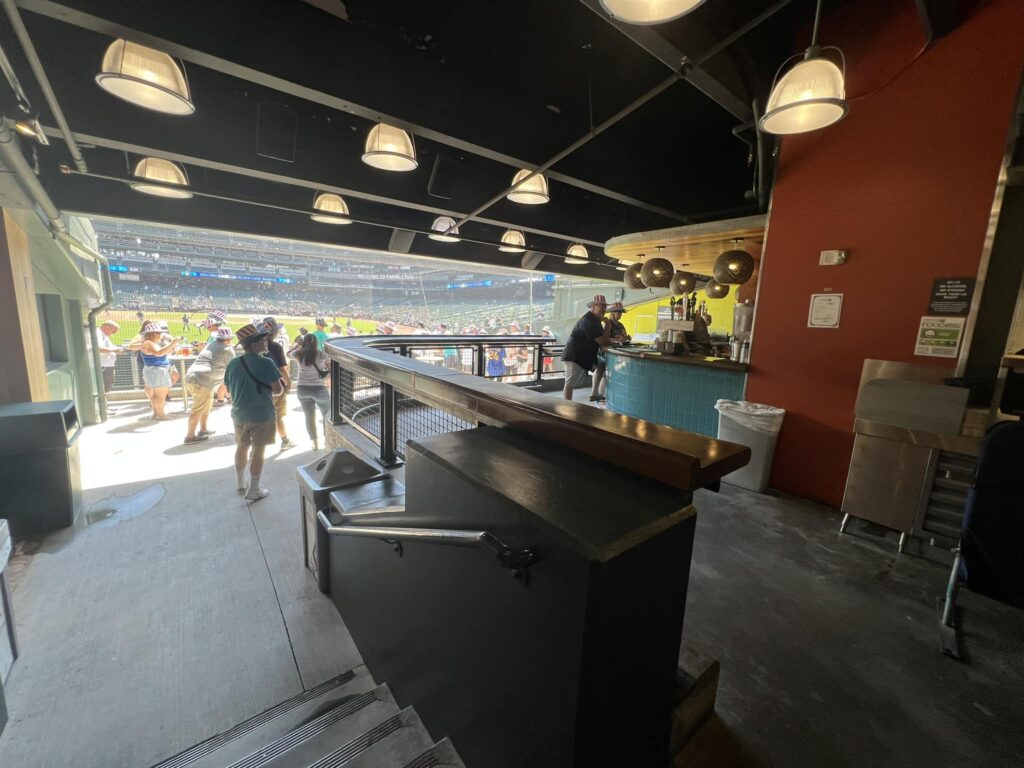
This also used to be the home of T-Mobile Park’s infamous chapulines, which translates to, wait for it, toasted grasshoppers! However, there is an issue with their supplier in Mexico, so I was told it’s unknown (August was speculated) when they will come back. But they are on the menu for this year. Maybe back for the All-Star Game as a surprise?
The Mariners Hall of Fame and Baseball Museum of the Pacific Northwest
Like many ballparks, Seattle’s T-Mobile Park features a dedicated historical exhibit. In this case, it’s the Mariners Hall of Fame and Baseball Museum of the Pacific Northwest.
Integrated with the Baseball Museum of the Pacific Northwest, the Hall of Fame features displays and bronze plaques of the 10 inducted members, Ken Griffey Jr., Jay Buhner, Edgar Martinez, Dave Niehaus, Randy Johnson, Lou Pinella, Ichiro, Alvin Davis, Dan Wilson (for some reason), and Jaime Moyer.
Each dedication briefly describes their achievements and includes TV highlights of their careers. The area also includes player memorabilia and a picture cut out of each player.
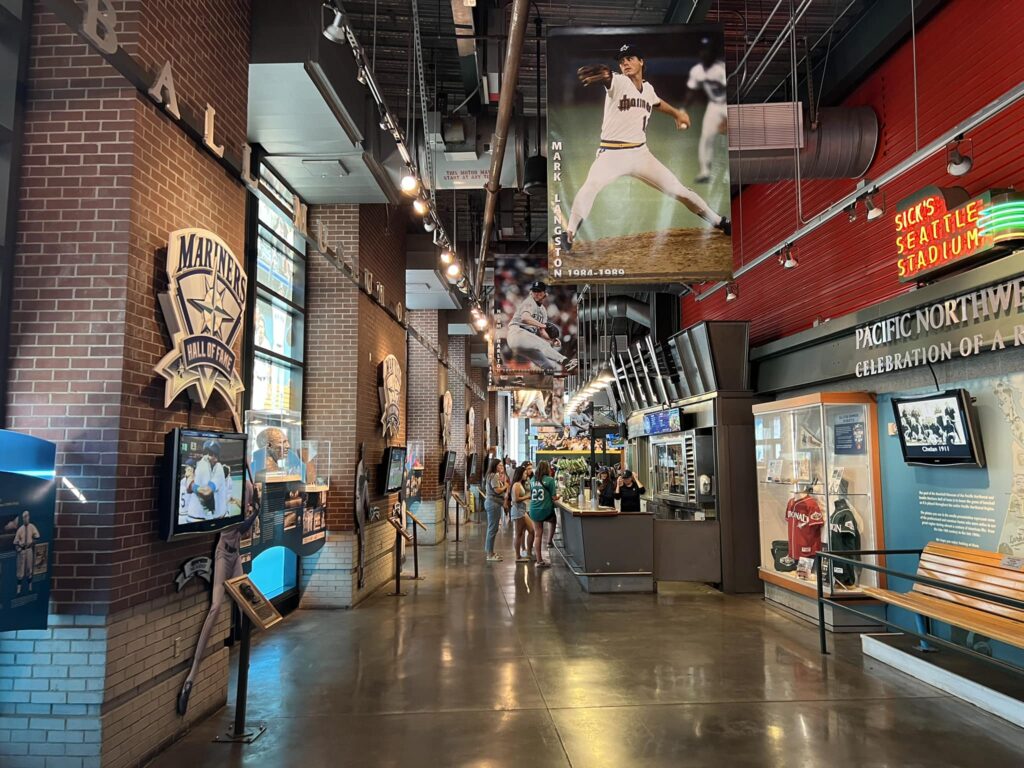
The Pacific Northwest exhibition is particularly interesting, featuring displays regarding the Pilots, memorabilia from Sicks Stadium, Seattle All-Star games, and the history of Seattle stadiums. There’s also a bust of Emil Sicks (“the man who saved baseball in Seattle”), Gold Glove displays, the original Kingdome dugout bench, and the bats first used at the Kingdome and Safeco Field.
The coolest concept is the replica outfield wall, where kids can pretend to be outfielders robbing home runs. There’s also a timeline of the history of the Mariners, plus an exact replica of Ken Griffey Jr.’s locker stall!
To top it all off, the museum includes its own bar with outstandingly valued ($6) 12-ounce high quality craft beers.
The Railroad Tracks
Some ballpark enthusiasts find this annoying (trains whistling by beyond right field during the game), but I find it cool. A series of railroad tracks sit below the retractable roof beyond right field.
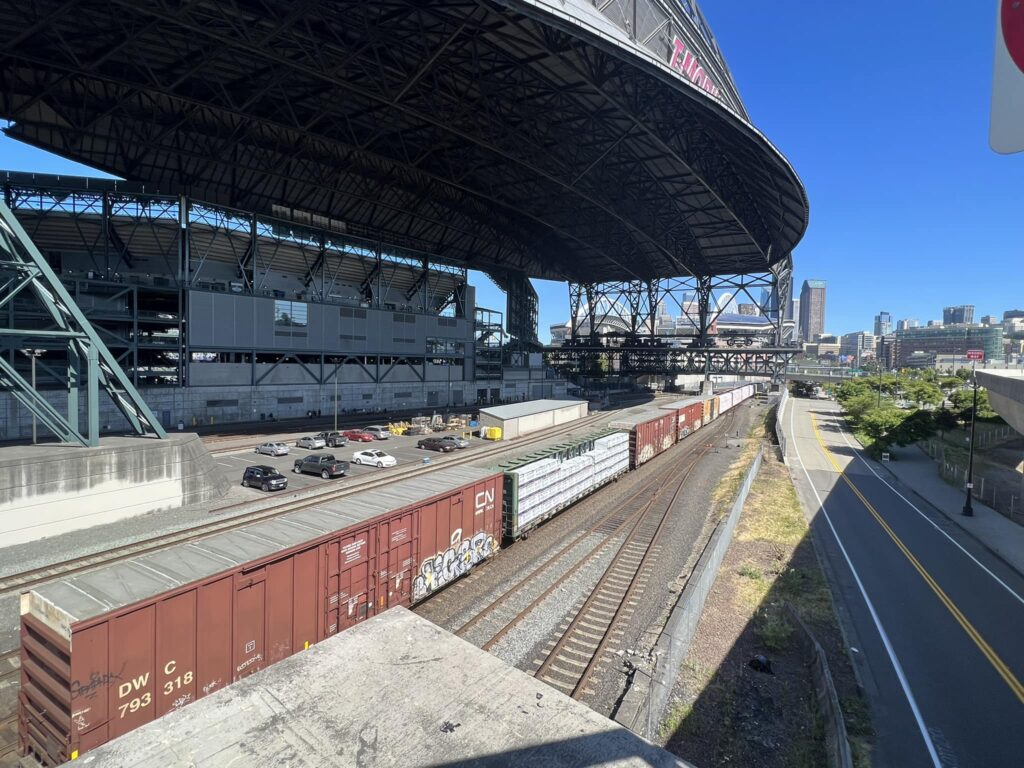
Worth a gander from the upper deck concourse in right field or the center field bleachers.
The Trident Deck, Rooftop Boardwalk, and Corresponding Views
T-Mobile Park added a nice series of social spaces in the upper deck in the late 2010s/early 2020s. Located in the left field corner, the Trident Deck showcases great views of the field and Seattle landmarks, including the skyline. This is also the only space with a full-service bar in the upper deck. It’s sometimes closed for private parties, however.
Seattle’s pad has always been known for great views of Elliott Bay and greater Puget Sound from the upper deck concourse, and that concept was enhanced by the addition of the Rooftop Boardwalk.
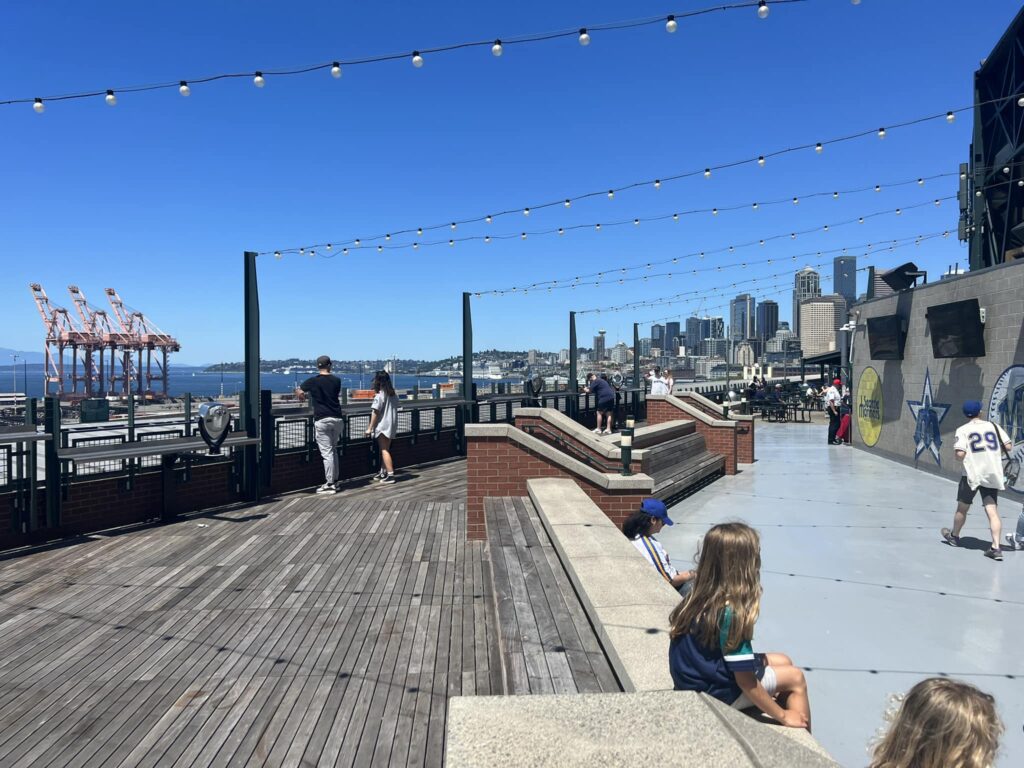
Located above the rotunda, the Boardwalk features elevated viewing areas with drink rails, tables, and coolest of all, tower viewers allowing fans to see even Washington’s most distant natural features.
The Diamond Club (if you can afford it or have connections)
All but three MLB parks feature some sort of ultra-premium seating in the first rows behind home plate, and most of those include access to all-inclusive VIP clubs like this one. So, I only choose to highlight Seattle’s version because it’s one of the very best.
Newly renovated for the 2023 season, the Diamond Club consists of the first eight rows of the theatre style seats behind home plate and includes access to a gorgeous club with everything included in the ticket price. A gourmet buffet, action cooking stations, ballpark food, beer, wine, liquor, handmade cocktails. The works.
That all isn’t too unusual, but naturally for being brand new, this club is notable for its fit and finish, incomparable design, and attention to detail.
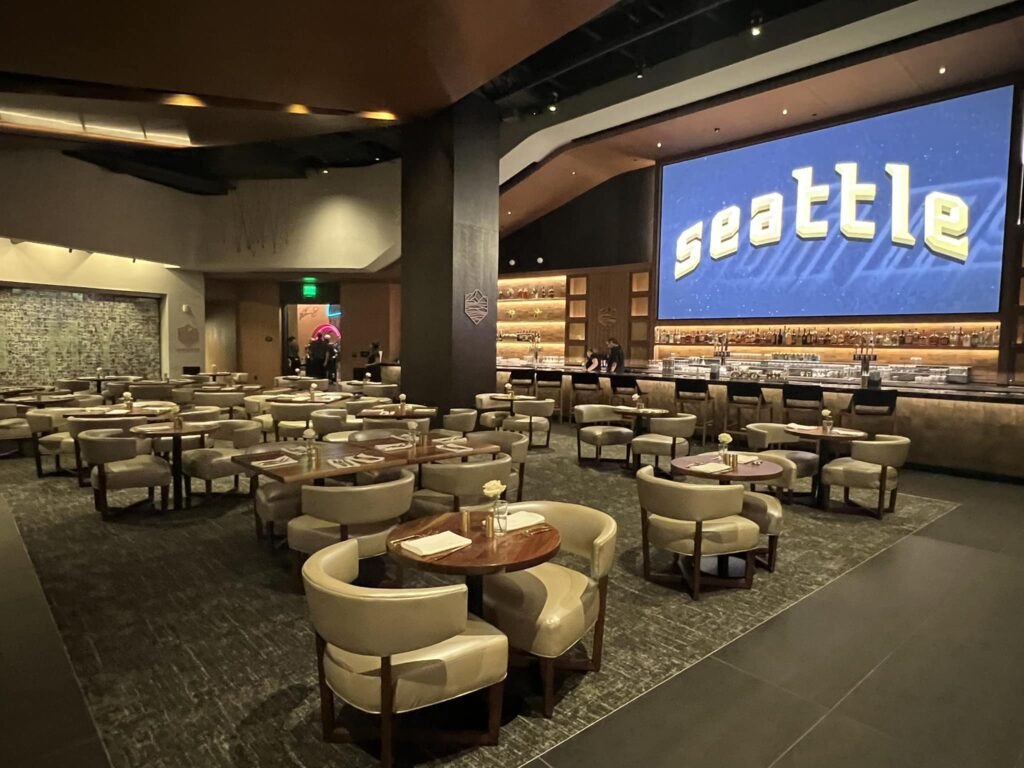
A 20-foot wide 4k television above the bespoke bar. An expresso bar. A candy wall and a creamery. Dining booths are named after Mariners’ legends. Outside of the club’s entrance at the service level, there’s a giant mural of Ken Griffey Jr. blowing bubble gum, light feature included. Inside, there’s the massive “My Oh My” baseball card wall with 1000s of cards showcasing the full spectrum of Mariners’ history. And plenty of artwork inside of the club.
Plus, the in-seat service is particularly outstanding, where servers will bring you not just ballpark items, beer, and wine, but essentially anything, including craft cocktails from the bar.
I don’t always recommend these VIP home plate clubs (at $500+ per game, is it worth the cost?), but this one is special. If you’re a diehard Mariners’ fan or a ballpark enthusiast, save up and do this once in your lifetime. Full review of this experience coming soon.